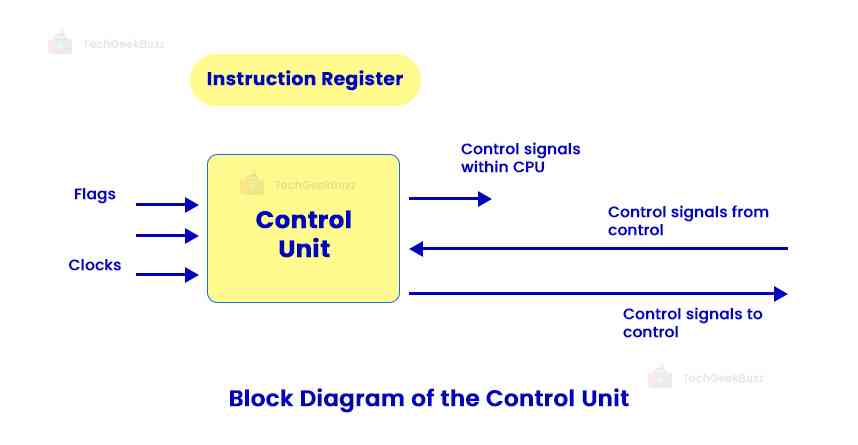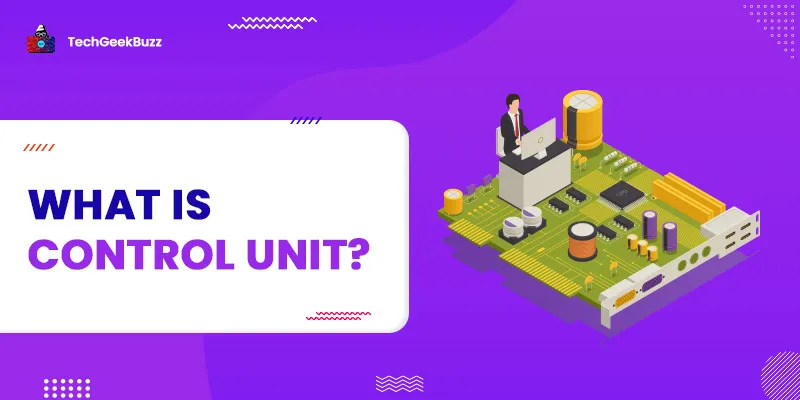We use computer systems every day to perform a variety of tasks. After we provide the input, the computer processes it and displays the intended results. Have you ever wondered how the computer does this? Well, the control unit of the CPU (Central Processing Unit) is responsible for this.
The control unit is one of the components of the CPU responsible for controlling all the activities a computer performs.
This blog post will introduce you to the control unit, its working, functions, and types.
So, let us start without any delay.
What is a Control Unit?
A control unit, or CU, is among the three components of the CPU, alongside the arithmetic and logic unit and memory unit. It regulates the processor’s or CPU’s operations. It governs the two other CPU components, the arithmetic and logic unit and memory unit, and input and output devices and tells them how to respond to instructions sent to the processor.
This unit is responsible for managing most of the computer resources. It controls the data flow between the CPU and other devices. Further, it issues orders to all other units and ensures that all instructions execute correctly. In short, the control unit is the brain of the CPU.
How Does a Control Unit Work?

A control unit retrieves internal program instructions from the main memory and loads them to the processor instruction register. Depending on the content of the instruction register, the CU generates control signals to regulate the instruction execution.
Components of Control Unit
- Instruction Register (IR): It stores instructions retrieved from the main memory.
- Input Flags: They are status indicators, also called condition flags, the control unit leverages to make decisions about carrying out operations, depending on the system’s state.
- Clock Signals: They are in charge of synchronizing the operations of the control unit and other CPU components. This ensures that the processing of data and instructions takes place at a consistent time interval.
- Control Signals within the CPU: The control unit generates the control signals to coordinate the activities between CPU components.
- Control Signals to/from the Bus: These signals enable data exchange between the control unit and other components connected to the control bus, such as memory, I/O devices, and other peripherals.
- Control Bus: It is a set of electrical lines that serve as an interface between the control unit and other devices.
Working
When the user provides input to a computer, the control unit (CU) receives it and converts it into control signals. Later, the CU transmits these signals to the central processor. The CPU then instructs the associated hardware to carry out the specific operations.
In this way, the control unit monitors the computer's operations and activities while executing a program . Besides the CPU, the GPU (Graphical Processing Unit) also requires a control unit.
However, it is important to note that the functions of the control unit vary depending on the type of CPU architecture , as it varies from manufacturer to manufacturer.
Functions of a Control Unit
The following are the functions of a control unit –
- The control synchronizes the data flow between different components of the processor.
- It interprets user commands and instructions.
- It converts the received commands and instructions into control signals.
- The control unit regulates many other execution units, such as ALU, data buffers, registers, etc.
- Fetching, decoding, handling execution, and storing results are some of the activities performed by CU.
Advantages of a Well-Designed Control Unit
Having a well-designed control unit offers the following advantages –
- Enhanced Performance: A control unit with a good design offers a high performance by increasing clock speed, reducing latency, and improving throughput.
- Improved Reliability: With the ability to detect and address errors, such as memory errors and pipeline stalls, a control unit with ingenious design improves reliability.
- Streamlined Instruction Execution: A well-designed control unit optimizes the instruction pipeline and reduces the number of clock cycles for each instruction. Hence, it ensures the streamlined and efficient execution of instructions.
- Executes Complex Instructions: It executes complex instructions requiring multiple operations.
- Less Power Consumption: A thoughtfully designed control unit optimizes the use of resources, such as registers and memory. This, in turn, reduces the number of clock cycles required for each instruction. Hence, it requires less power consumption.
- Increased Security: It implements security features for improved security.
- Accurate Branch Prediction: A control unit with an intelligent design can predict an accurate branch, resulting in improved performance.
- High Scalability: The CPU can handle large and complex workloads with an intelligently designed control unit, which results in higher scalability.
- Parallel Execution Capability: The CPU with a well-designed control unit can execute multiple instructions simultaneously.
Disadvantages of a Poorly-Designed Control Unit
Here are some significant disadvantages of a poorly-designed control unit –
- Increased Complexity: A poorly-designed control unit makes it difficult for the processor to execute tasks, increasing its complexity.
- Decreased Performance: Increased latency, reduced throughput, and the introduction of pipeline stalls result in decreased CPU performance.
- High Power Consumption: When a control unit is ill-designed, it cannot use the resources efficiently, resulting in more clock cycles for each instruction. Therefore, it leads to high power consumption.
- Security Vulnerabilities: Code injection attacks and buffer overflows are typical security vulnerabilities to which a poorly-designed control unit is susceptible.
- High Cost: The CPU’s manufacturing complexity increases with a poorly-designed control unit, increasing the cost.
Conclusion
This was all about the control unit. It is the brain of the central processing unit (CPU) that controls all its activities and operations. Also, it regulates other CPU components and the data flow between them. The functions of a control unit mentioned above are generic. It is important to note that they vary depending on the CPU architecture.
We hope this article has provided enough information on the control unit. If you have any queries, let us know in the comments.
People are also reading:


![What is an Assembler? [Definition, Working, & Types]](/media/new_post_images/What_is_Assembler.jpg)
![What is I/O? [Types, Examples, & Methods]](/media/new_post_images/What_is_I_O.webp)

Leave a Comment on this Post